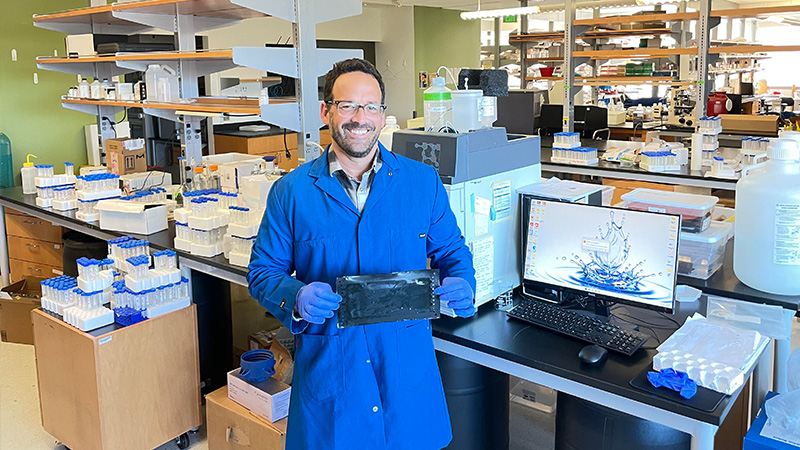Ion-Specific Membrane Holds Potential to Improve Energy Storage and Water Filtration
UCLA engineers develop filters that can fine tune selection of a specific particle

Raj Iyer/UCLA
Professor David Jassby shown in his lab holding an ion-specific membrane that allows only one ion species to cross
UCLA Samueli Newsroom
Contemporary batteries and fuel cells rely on membranes that let through certain charged particles, or ions, but not others. However, today’s membranes are unable to select for just one type of ion, especially if the unwanted ions are similar in size or charge.
Now, UCLA engineers and their collaborators have developed a membrane so selective, it can be fine-tuned to allow only a single type of ion to pass through it. In a recent study published in Nature Nanotechnology, the researchers demonstrated that their membrane allowed phosphate ions to pass through, but not other types of charged particles. The technology may pave the way for advances in not only energy storage but also water filtration.
“Enabling highly selective precision separation between ions of similar size and charge would facilitate multiple desirable processes, particularly for extracting and recovering important resources,” said David Jassby, an associate professor of civil and environmental engineering at the UCLA Samueli School of Engineering and the study’s principal investigator.
In the paper, the research team postulated that the principles behind their ion-selective membrane could be applied to charged particles of lithium, gold, uranium and other popular elements.
“Enabling highly selective precision separation between ions of similar size and charge would facilitate multiple desirable processes, particularly for extracting and recovering important resources,” said David Jassby.
For example, lithium is in high demand for use in lithium-ion batteries that power everything from consumer electronics to electric cars. But lithium in its pure, elemental form does not occur in nature. Instead, lithium is found in ionic salt compounds from which it has to be chemically extracted. Incorporating a membrane that filters for only lithium ions may significantly streamline extraction. This could make it easier to tap lithium sources that are currently challenging to use, such as the salty wastewater from geothermal energy plants or byproducts from oil and gas extraction.
To make the highly selective membrane, the researchers grew nanoparticles of hydrous manganese oxide (HMO), an inorganic compound used to absorb radioactive metal from water inside a polymer matrix.
The HMO particles have phosphate-specific binding sites, but those bonds are not so strong that phosphate ions are trapped within the membrane. Instead, the ions hop from one HMO particle to another, similar to stepping stones in a pond, until they have crossed through the membrane. Meanwhile, the polymer matrix itself — comprising molecules with fixed negative charges — prevents other, competing negatively charged ions from passing through the membrane.
Arpita Iddya, a postdoctoral scholar in Jassby’s lab, led the research. Other co-authors are Chia Miang Khor, Shengcun Ma and Jingbo Wang from UCLA’s Department of Civil and Environmental Engineering as well as Eric Hoek, a professor of civil and environmental engineering at UCLA and a staff scientist at the Lawrence Berkeley National Laboratory. Piotr Zarzycki and Ryan Kingsbury from Berkeley Lab, Ian Wheeldon from UC Riverside and Zhiyong Jason Ren from Princeton University also contributed to the research.
This research was funded by grants from the U.S. Department of Agriculture and the U.S. Department of Energy’s Chemical Sciences, Geosciences, and Biosciences Division.
Natalie Weber contributed to this story
